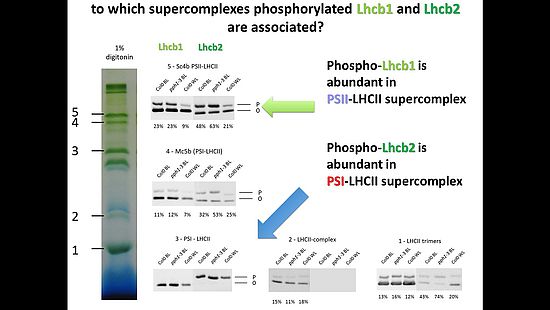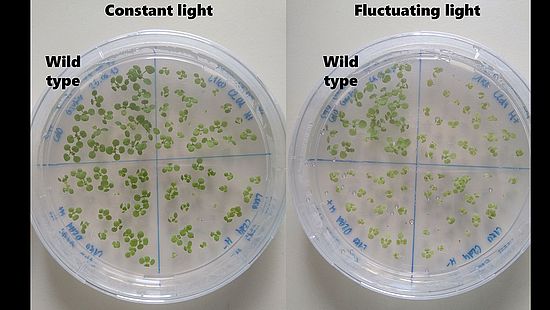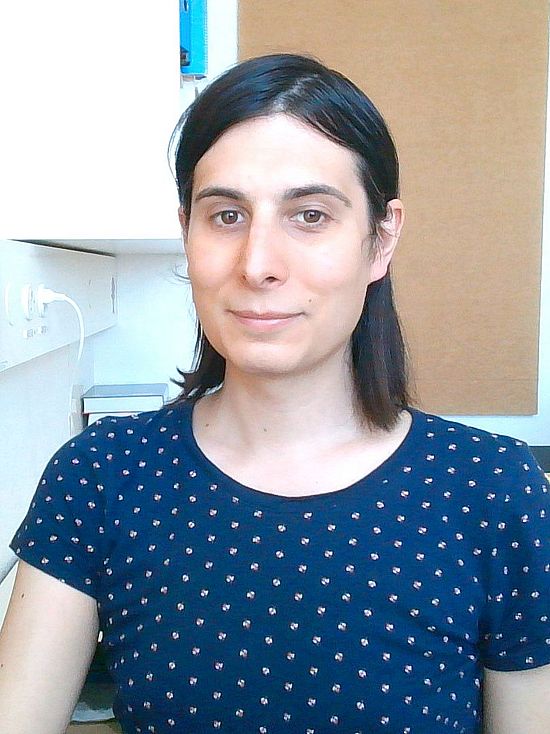Dynamics of the light harvesting complex
Photosynthetic acclimation
The light harvesting complex is composed of trimeric and monomeric antenna proteins containing Chlorophyll a and b pigments and carotenoids. Its role is to capture the light energy and transfer it in the form of excitation to the chlorophyll of the reaction centers and to dissipate the excess of light energy when the light input overcomes the photosynthetic capacity. Furthermore, constituting a large portion of the photosynthetic protein, the light harvesting complex play a role on the overall organisation of the thylakoid membrane. The goal of the research project is to investigate the role of the phosphorylation of each LHCII subunit in the photosynthetic acclimation to different light conditions. The project aims to answer the following questions: What are the specific roles of the different isoforms? Would a modified isoform lacking the N-terminal phosphorylation still allow acclimation to different light conditions? What is the contribution of the N-terminus and the protein core in defining the role of each isoform? Is it possible to alter the phosphorylation kinetics and will this affect the adaptation dynamics?
Recent Publications
- A microalgal-based preparation with synergistic cellulolytic and detoxifying action towards chemical-treated lignocellulose
Benedetti, Manuel; Barera, Simone; Longoni, Paolo; Guardini, Zeno; Garcia, Natalia Herrero; et al.
Plant Biotechnology Journal DOI: 10.1111/pbi.13447 SEP 2020 - Regulation of Light Harvesting in Chlamydomonas reinhardtii: Two Protein Phosphatases Are Involved in State Transitions
Cariti, Federica; Chazaux, Marie; Lefebvre-Legendre, Linnka; Longoni, Paolo; Ghysels, Bart; et al.
Plant Physiology DOI: 10.1104/pp.20.00384 AUG 2020 - Growth Temperature Influence on Lipids and Photosynthesis in Lepidium sativum
Sattari Vayghan, Hamed; Tavalaei, Shahrzad; Grillon, Armand; Meyer, Lea; Ballabani, Gent; et al.
Frontiers In Plant Science DOI: 10.3389/fpls.2020.00745 JUN 4 2020 - Mutation of the Atypical Kinase ABC1K3 Partially Rescues the PROTON GRADIENT REGULATION 6 Phenotype in Arabidopsis thaliana
Pralon, Thibaut; Collombat, Joy; Pipitone, Rosa; Ksas, Brigitte; Shanmugabalaji, Venkatasalam; et al.
Frontiers In Plant Science, 10.3389/fpls.2020.00337, MAR 25 2020 - PROTEIN HOMEOSTASIS How chloroplasts protect themselves from unfolded proteins
Kessler, Felix; Longoni, Paolo
ELIFE 8 Article Number: e51430 DOI: 10.7554/eLife.51430 OCT 15 2019 - The Kinase STATE TRANSITION 8 Phosphorylates Light Harvesting Complex II and Contributes to Light Acclimation in Arabidopsis thaliana
Longoni, P; Samol, I; Goldschmidt-Clermont, M
FRONTIERS IN PLANT SCIENCE, 10 10.3389/fpls.2019.01156 SEP 19 2019 - Plastoquinone homoeostasis by Arabidopsis proton gradient regulation 6 is essential for photosynthetic efficiency
Pralon, Thibaut; Shanmugabalaji, Venkatasalam; Longoni, Paolo; Glauser, Gaetan; Ksas, Brigitte; Collombat, Joy; Desmeules, Saskia; Havaux, Michel; Finazzi, Giovanni; Kessler, Felix
COMMUNICATIONS BIOLOGY 2 Article Number: 220 DOI: 10.1038/s42003-019-0477-4 JUN 2019 - Comparison of transplastomic Chlamydomonas reinhardtii and Nicotiana tabacum expression system for the production of a bacterial endoglucanase
Fae, M; Accossato, S; Cella, R; Fontana, F; Goldschmidt-Clermont, M; Leelavathi, S; Reddy, VS; Longoni, P
APPLIED MICROBIOLOGY AND BIOTECHNOLOGY 101(10):4085-4092 10.1007/s00253-017-8164-1 MAY 2017 - Use of Nicotiana tabacum transplastomic plants engineered to express a His-tagged CP47 for the isolation of functional photosystem II core complexes
Pagliano, C; Bersanini, L; Cella, R; Longoni, P; Pantaleoni, L; Dass, A; Leelavathi, S; Reddy, VS
PLANT PHYSIOLOGY AND BIOCHEMISTRY 111: 266-273 https://doi.org/10.1016/j.plaphy.2016.12.009 FEB 2017 - Activation of the Stt7/STN7 Kinase through Dynamic Interactions with the Cytochrome b(6)f Complex
Shapiguzov, A; Chai, X; Fucile, G; Longoni P; Zhang, LX; Rochaix, JD
PLANT PHYSIOLOGY 171(1):82-92 10.1104/pp.15.01893 MAY 2016 - A Nucleus-Encoded Chloroplast Phosphoprotein Governs Expression of the Photosystem I Subunit PsaC in Chlamydomonas reinhardtii
Douchi, D; Qu, Y; Longoni, P; Legendre-Lefebvre, L; Johnson, X; Schmitz-Linneweber, C; Goldschmidt-Clermont, M
PLANT CELL 28(5):1182-1199 10.1105/tpc.15.00725 MAY 2016 - …
Research topics
- Photosynthesis acclimation
- Thylakoid organisation
- Protein dynamics
- Adaptation to different light condition
- Photosynthetic efficiency improvement
Interdisciplinarity
- Biophysical analysis of the photosynthetic parameters
- Protein complex isolation and native analysis
- Protein phosphorylation dynamics



